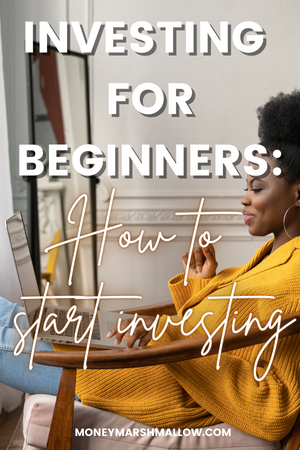Investing for beginners in the UK can be an exciting and rewarding journey towards financial freedom. However, navigating the world of investing can be daunting, especially for those who are new to the game. With so many investment options available, it can be difficult to know where to start, how to diversify your portfolio, and what risks to take.
In this article, we will provide a comprehensive guide on investing for beginners in the UK. We’ll cover why you should invest in stocks and shares, what the stock market is, what a beginner should invest in, and how to invest in stocks in the UK. We’ll also discuss investment platforms and tax-wrapped investment options and provide tips for successful investing.
Investing for beginners UK: Understanding the basics
What is investing?
Investing is the process of putting your money into assets that have the potential to grow in value over time. The goal of investing is to increase your wealth and achieve your financial goals, such as saving for retirement or buying a house.
There are many types of investments available, including stocks, bonds and more. Each investment comes with its own level of risk and potential reward. Generally, the higher the potential reward, the higher the risk.
What is the stock market?
The stock market is a marketplace where stocks, shares, and other securities are bought and sold. The stock market can be intimidating for beginners, but it’s important to understand its basic workings.
Stock prices are determined by supply and demand. When there are more buyers than sellers, stock prices go up. When there are more sellers than buyers, stock prices go down.
The stock market can be volatile, meaning that stock prices can change rapidly and unpredictably. It’s important to remember that investing in stocks and shares comes with risks, and you should be prepared for the possibility of losing money if you sell at the wrong time.
Why invest in stocks and shares?
Stocks and shares are a popular type of investment and for good reason. Investing in stocks and shares can offer the potential for higher returns compared to other types of investments, such as savings accounts or bonds. However, stocks and shares also come with higher risks.
Over the long term, stocks and shares have historically provided higher returns than other types of investments. For example, from 1923 to 2023, US stocks (S&P 500) had an average annual return of 10.4%, while long-term government bonds had an average annual return of around 5%.
Investing in stocks and shares also allows you to own a part of a company. As a shareholder, you have the potential to benefit from the company’s profits through dividend payments and share price appreciation.

How much money should a beginner have before investing?
It is a common financial misbelief that you need a lot of money to be able to start investing. But in fact, there is no minimum amount of money required to start investing. However, it’s still important to have a solid financial foundation in place before investing. This includes having an emergency fund with enough savings to cover unexpected expenses and paying off high-interest debt.
As a general rule, it’s recommended to start with a small amount of money and gradually increase your investment as you become more comfortable with the process. This can help you avoid investing more than you can afford to lose.
Many investment platforms in the UK offer low minimum investment amounts, making it easier for beginners to start investing with as little as £50 or £100.
What should a beginner invest in?
As a beginner investor, it’s important to choose investments that fit your risk tolerance and investment goals. Here are some options to consider:
Exchange-Traded Funds (ETFs): ETFs are a type of investment fund that hold a basket of assets, such as stocks or bonds. They are traded on the stock exchange like individual stocks, making them a convenient option for beginners. ETFs can offer diversification and lower costs compared to buying individual stocks.
Bonds: When you invest in a government bond or gilt, you are lending money to a government in return for interest.
Investment Trusts: Investment trusts are similar to ETFs in that they hold a portfolio of assets. However, they are structured as companies and are traded on the stock exchange like individual stocks. Investment trusts can offer diversification and potentially higher returns compared to ETFs.
Individual Stocks: Investing in individual stocks can offer the potential for higher returns, but it also comes with higher risks. It’s important to do your research and choose stocks that fit your risk tolerance and investment goals.
Investing for beginners UK: How to get started
Investing can seem complex, especially for beginners. In fact, many people overthink investing, which can discourage them from starting altogether. But don’t worry—you don’t need to be an expert to get started. Just by reading this article, you’re on the right track!
To invest in stocks in the UK, you need to decide what you want to invest in, choose an investment platform, stockbroker, or financial advisor, and select a tax wrapper. But before all that, you need to consider your investment goals and strategy. Here is a step-by-step guide to follow to get you started with investing.
1. Set your investment goals and risk tolerance
Before you invest any money, you need to define your investment goals and risk tolerance. Your investment goals will determine the type of investments that you choose and how much you should invest. Your risk tolerance is the level of risk that you’re comfortable taking on with your investments.
When setting your investment goals, you should consider factors such as your age, financial situation, and future plans. For example, if you’re young and have a long time horizon, you may be comfortable with higher-risk investments that offer the potential for higher returns. On the other hand, if you’re nearing retirement, you may want to focus on investments that offer more stability and income.
In addition, you should also consider your risk tolerance. This is the level of risk that you’re comfortable taking on with your investments. If you’re a conservative investor, you may want to focus on low-risk investments such as bonds or money market funds. If you’re a more aggressive investor, you may want to focus on higher-risk investments such as stocks or mutual funds.

2. Choose a tax wrapper
A tax wrapper is a type of tax break that you can use for your investments to shield them from paying some or all of the tax on it. When investing in the UK, it’s important to choose a tax wrapper that suits your goals and preferences. Some common options include:
Stocks and Shares ISA: This is a tax-efficient way to invest in a range of assets, including stocks, bonds, and funds. Any income or capital gains earned within the account are tax-free, and the annual contribution limit is £20,000.
Lifetime ISA: A Lifetime ISA is a tax-efficient way to save for your first home or retirement. You can contribute up to £4,000 per year, and the government will add a 25% bonus to your contributions, up to a maximum of £1,000 per year.
Pensions: There are two types of pensions to consider:
- Workplace pensions: These are arranged by your employer, with contributions made by both you and your employer. Workplace pensions offer tax relief on contributions.
- Personal pensions and SIPPs: These are pensions that you set up yourself. You can contribute up to £40,000 per year (or 100% of your earnings) and the contributions are eligible for tax relief. You can invest the funds in a range of assets.
Consider your eligibility, contribution limits, investment options, and tax implications when choosing a tax wrapper. Seeking advice from a financial professional can also be helpful.
3. Select an investment platform
There are several investment platforms available in the UK, each with its own fees, minimum investment amounts, investment options, and user experience. Some common investment platforms for beginners include Vanguard and InvestEngine. Research and compare different platforms to choose one that meets your needs and budget.
We will cover more information about different beginner-friendly investing platforms in the next section.
4. Open an investment account
Once you’ve selected a platform, sign up for an investment account and complete the necessary documentation. Some platforms may require proof of identity and residency, so be prepared to provide these documents.
5. Decide your investment strategy
Your investment strategy will depend on your investment goals, risk tolerance, and time horizon. There are different investment strategies that you can consider, such as value investing, growth investing, income investing, and index investing.
Value investing involves finding undervalued stocks that are trading at a discount to their intrinsic value. Growth investing involves investing in companies that have strong growth potential. Income investing involves investing in stocks that offer a high dividend yield. Index investing involves investing in a broad-based index fund that tracks the performance of a market index, such as the S&P 500.
When deciding on your investment strategy, it’s important to do your research and understand the risks and potential rewards of each strategy. You may also want to consider working with a financial advisor to help you develop an investment strategy that’s tailored to your needs and goals.
Related: 4 Questions to help you create your investment plan
6. Make your first investment
Once you’ve selected your investments, make your first investment by following the instructions on your chosen platform. Be mindful of transaction fees and any other costs associated with buying and selling investments.
7. Monitor your investments
When monitoring your investments, it’s important to strike a balance between being informed and being reactive. Checking your investment account too frequently can lead to knee-jerk reactions to short-term market movements, which can be detrimental to your long-term investment goals.
As a long-term fund investor, you should check your investment account regularly but not obsessively. Quarterly or semi-annual reviews are a good rule of thumb, allowing you to evaluate your investment performance and make any necessary adjustments to your portfolio.

Best investment platforms for beginners
Investing has become more accessible than ever before thanks to the rise of investment platforms. These platforms provide an easy and affordable way for beginners to start investing their money. Here are some of the best investment platforms for beginners in the UK.
1. Vanguard
Vanguard is a low-cost investment platform that offers a range of funds and ETFs. The platform is ideal for passive investors who want to invest in a diversified portfolio of low-cost index funds. Vanguard has a minimum investment of £500 for single investments or a minimum of £100 per month. The platform charges a low management fee based on the size of your portfolio.
2. InvestEngine
InvestEngine is great for beginners, due to it being budget-friendly and exclusively focused on ETF investing. It offers a choice between a managed or DIY portfolio approach, making investing simpler. The platform also streamlines the process with automated investing features and fractional investing. Opening an InvestEngine account starts with a minimum investment of £100. Notably, DIY portfolios come with no fees, while managed portfolios have a 0.25% charge – a standout feature compared to other platforms. They also offer a welcome bonus of up to £50 when you invest your first £100 (Ts&Cs apply).
3. Nutmeg
Nutmeg is a popular robo-advisor platform that offers a fully managed investment portfolio. The platform uses advanced algorithms to create a portfolio that is tailored to your investment goals and risk tolerance. Nutmeg offers a range of investment portfolios, including socially responsible and fixed allocation portfolios, and has a minimum investment of just £500.
4. Moneyfarm
Moneyfarm is another robo-advisor platform that offers a range of investment portfolios. The platform uses a simple questionnaire to determine your investment goals and risk tolerance and then creates a portfolio that’s tailored to your needs. Moneyfarm has a minimum investment amount of £500 and charges a management fee based on the size of your portfolio.
5. Hargreaves Lansdown
Hargreaves Lansdown is a popular investment platform that offers a wide range of investment options, including stocks and shares, funds, and ETFs. The platform also offers a range of investment tools and research to help you make informed investment decisions. Hargreaves Lansdown has a minimum investment of £100 and charges a management fee based on the size of your portfolio.
When choosing an investment platform, it’s important to consider factors such as fees, investment options, and ease of use. You should also consider your investment goals and risk tolerance and choose a platform that’s tailored to your needs.
Typical investment fees
When it comes to investing, it’s important to be aware of the various fees that may be associated with your investments. Here are some typical investment fees you should look out for:
Account or platform fee: This is a fee charged by the investment platform for using their services. It can be a fixed monthly fee or a percentage of your invested assets.
Trading or transaction fee: This is a fee charged by the investment platform every time you buy or sell an investment. It can be a flat fee or a percentage of the transaction value.
Ongoing or annual management charge: This is a fee charged by the investment company for managing your investments. It is typically charged as a percentage of your invested assets and can range from 0.1% to 2%.
Advice fee: If you choose to work with a financial advisor or investment manager, they may charge an advice fee. This can be a one-time fee or an ongoing fee that is usually charged as a percentage of your invested assets.
It’s important to be aware of these fees before you start investing, as they can eat into your returns. Some investment platforms offer lower fees than others, so it’s worth shopping around to find the best deal. You should also consider the impact of fees on your investment returns when deciding whether an investment is right for you.
Takeaway investing tips for beginners
If you’re new to investing, it’s understandable to feel a little nervous about getting started. But with the right approach, investing can be a great way to build wealth over time. Here are some final takeaway tips to help you get started on your journey:
- Set up an emergency fund: Save up an emergency fund of 3 to 6 months’ worth of living costs before you invest. It is important to have a safety net in case something unexpected happens
Take advantage of tax-free accounts: Consider using a tax wrapper like a Stocks and Shares ISA, Lifetime ISA, Pension or SIPP (self-invested personal pension) to reduce your tax liabilities. These wrappers can help you keep more of your investment returns and reduce your overall tax bill.
Choose your platform wisely: Use a reputable investment app or platform that offers a range of investment options and low fees. This will help you keep your investment costs low and give you access to a wide range of investment options.
Don’t put all your eggs in one basket: It is important to diversify your investments. This means investing in different asset types (e.g. shares, bonds) in various sectors and across different geographies. By spreading your investments, you can reduce the impact of any one investment performing poorly.
Review your portfolio: Monitor your investments regularly, but avoid checking too frequently as this can lead to unnecessary stress. Regular monitoring will allow you to make any necessary adjustments to your portfolio, but avoid overdoing it.
Focus on long-term returns: Be prepared to hold onto your investments for the long term to ride out any short-term fluctuations in the market. Investing is a long-term game, and it’s important to stay committed to your investments through market ups and downs.
By following this Investing for Beginners UK guide, you can start your investing journey with confidence and build a diversified portfolio that helps you reach your financial goals. Remember to keep your eye on the prize and stay focused on your long-term objectives.

